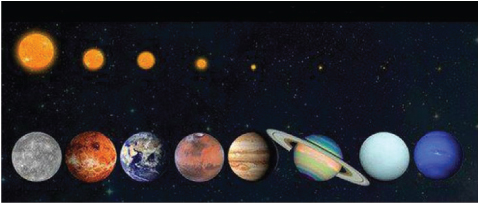2.2 Distances between the Solar System planets
Activity 2 will help you to visualise the distances between the planets in our Solar System.
Activity 2 Toilet roll Solar System distances
You need:
- a new roll of toilet paper (preferably strong)
- a felt-tip pen.
Open the roll and unroll the first few sheets. Place a mark on the seam in between the first two sheets and label this as the Sun. Then count the following numbers of sheets and make a mark for each of the Solar System planets (if you want to be very accurate, use fractions of a sheet as indicated by the numbers in brackets).
| Planet | Number of sheets from previous planet |
|---|---|
| Mercury | 1 |
| Venus | 1 (0.9) |
| Earth | 1 (0.7) |
| Mars | 1 (1.3) |
| Jupiter | 9 (9.5) |
| Saturn | 12 (11.3) |
| Uranus | 25 (24.9) |
| Neptune | 28 (28.0) |
Notice that as you go further out the planets generally become more distant from each other. The Sun would look much smaller and its light and heat would seem much weaker from the outer Solar System planets (Figure 3 below).
Mercury is about 58 million kilometres from the centre of the Sun, so in this activity one sheet of toilet paper represents this distance. This is similar to the way that a map gives a scaled-down picture of an area on the Earth. The scale of a map is usually represented as a ratio such as 1 : 50 000. This means that 50 000 cm on the ground is represented on the map by 1 cm. As 50 000 cm is the same as 500 m, a kilometre (2 × 500 m) would be represented by 2 cm on such a map.
We can work out the scale of your toilet paper Solar System. Don’t worry if you don’t understand this immediately – read through it slowly to give yourself a fair chance. It’s not the end of the world if you don’t get the hang of it!
One sheet represents the distance between the Sun and Mercury, 58 million kilometres. Assuming your toilet paper has sheets which are about 15 cm long, this is a scale of
1 sheet : 58 million km
so 15 cm : 58 million km
Converting the right-hand side first to metres and then to centimetres to match the units on the left-hand side, this is
15 cm : 58 billion m
15 cm : 5800 billion cm
Dividing both sides of the scale by 15, this becomes about
1 cm : 387 billion cm
So we can say that the approximate scale is 1 : 400 billion or 1 : 400 000 000 000, which is quite a bit more compressed than the 1 : 50 000 maps which tourists often use to explore. The Solar System is really big!
Figure 3 shows the relative approximate size of the Sun as seen from the other planets in the Solar System. It is very small and faint when seen from Uranus and Neptune.
Maths help
The following OpenLearn resources may help with the maths in this section. Open the link in a new tab or window by holding down Ctrl (or Cmd on a Mac) when you click on the link. Remember to return here when you have finished.
- changing units (Section 1.1) [Tip: hold Ctrl and click a link to open it in a new tab. (Hide tip)]
- converting units (Sections 2.2, 2.2.1 and 2.4)

